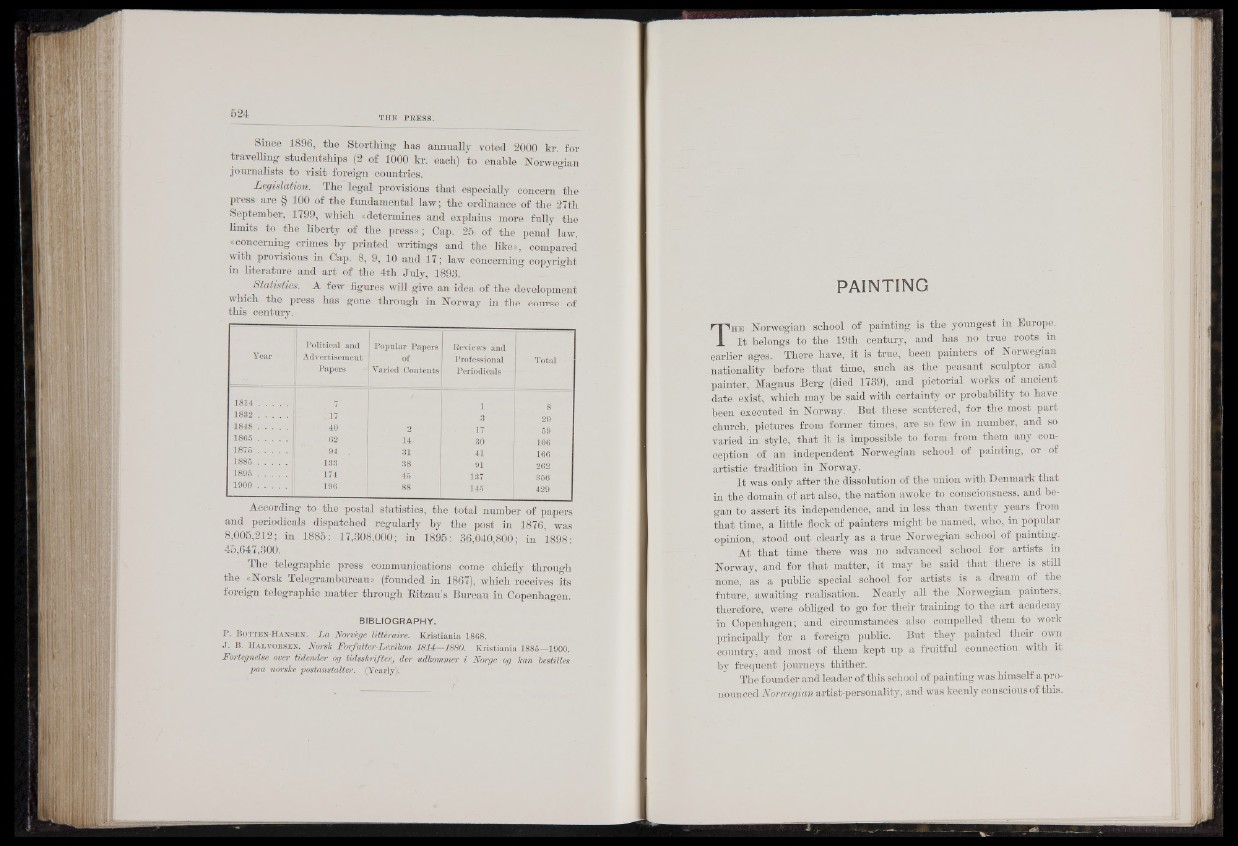
Since 1896, the Storthing has annually voted 2000 kr. for
travelling studentships (2 of 1000 kr. each) to enable .Norwegian
journalists to visit foreign countries.
Legislation. The legal provisions that especially concern the
press are § 100 of the fundamental law; the ordinance of the 27th
September, 1799, which «determines and explains more fully the
limits to the liberty of the press»; Cap. 25 of the penal law,
«concerning crimes by printed writings and the like», compared
with provisions in Cap. 8, 9, 10 and 17; law concerning copyright
in literature and art of the 4th July, 1893,
_ Statistics. A few figures will give an idea of the development
which the press has gone through in Norway in the course of
this century.
Year
I Political and
Advertisement
Papers
Popular Papers
of
Varied Contents
Reviews and
Professional
Periodicals
Total
1814 . . . ■ ^ 1 8
1882 . . .
• F 1 3 20
1848 . . . 40 2 17 59
1865 . . . • _ - 62 14 30 106
1875
* 94 ' 31 41 166
1885 133 3ß 91 262
1895 174 45 137 356
1900 196 88 145 429
According to the postal statistics, the total number of papers
and periodicals dispatched regularly by the post in 1876, was
8,005,212; in 1885: 17,308,000; in 1895 : 36,040,800; in 1898-
45,647,300.
The telegraphic press communications come chiefly through
the «Norsk Telegrambureau» (founded in 1867), which receives its
foreign telegraphic matter through Bitzau’s Bureau in Copenhagen.
BIBLIOGRAPHY.
P. B o t t en -Ha n s e n . L a Norvège littéraire. K r is tia n ia 1868.
J. B. H a l v o e s e n . Norsk Forfatter-Lexikon 1814—1880. Kristiania 1885— 1900.
Fortegneise over tidender og tidsskrifter| der udkommer i Norge og kan bestilles
paa nörske postanstalter. (Yearly).
PAINTING
Th e Norwegian school of painting is the youngest in Europe.
I t belongs to the 19th century, and has no true roots in
earlier ages. There have, it is true, been painters of Norwegian
nationality before that time, such as the peasant sculptor and
painter, Magnus Berg (died 1739), and pictorial works of ancient
date exist, which may be said with certainty or probability to have
been executed in Norway. But these scattered, for the most part
church, pictures from former times, are so few in number, and so
varied in style, that it is impossible to form from them any conception
of an independent Norwegian school of painting, or of
artistic tradition in Norway.
I t was only after the dissolution of the union with Denmark that
in the domain of art also, the nation awoke to consciousness, and began
to assert its independence, and in less than twenty years from
that time, a little flock of painters might be named, who, in popular
opinion,. stood out clearly as a true Norwegian school of painting.
At that time 'there was no advanced school for artists in
Norway, and for that matter, it may be said that there is still
none, as a public special school for artists is a dream of the
future, awaiting realisation. Nearly all the Norwegian painters,
therefore, were obliged to go for their training to the art academy
in Copenhagen; and circumstances also compelled them to work
principally for a foreign public. But they painted their own
country, and most of them kept up a fruitful connection with it
by frequent journeys thither.
The founder and leader of this school of painting was himself a pronounced
Norwegian artist-personality, and was keenly conscious of this.